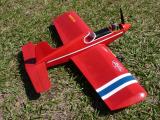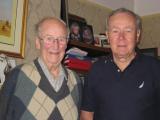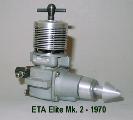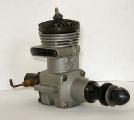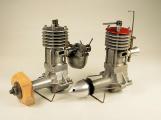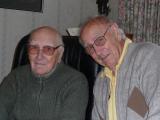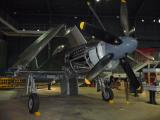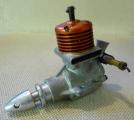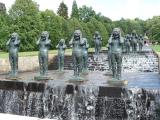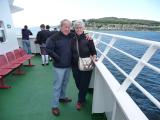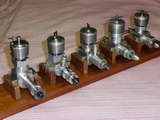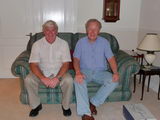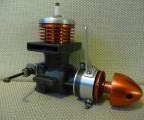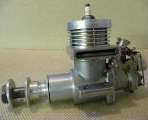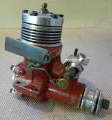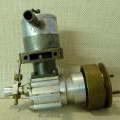David Owen's 2010: An Engine Odyssey
Part I: England
Click on images to view larger picture.
Hover over images for more information.
Celia and I arrived at Heathrow one morning early last August. We picked up a new Ford Focus hatchback, fitted with a 1.6 litre turbo diesel. Not our first choice, as we were hoping to get a diesel Golf. However, after living with the Focus for a month and 5500km, it turned out to be a truly excellent vehicle with an average fuel consumption of 5.2 litres/ 100km over the entire trip, much of which was at speeds we can only dream about here in Australia.
A day or so after catching up with our eldest son David, who lives in London, we drove up to Bushey, near Watford, to pick up a dear old friend, Ron Moulton. We first met at Old Warden in 1984 and Celia and I were privileged to look after him for a few days at the time of his great visit to Australia. Since then I have never missed an opportunity to catch up with Ron whenever possible and enjoyed his company immensely.
Ron Moulton will need no introduction. For many years he was the face of British aeromodelling, so well-known for his cheerful, endearing manner, his stewardship of Aeromodeller and other Argus/MAP magazines, his excellent plans, his books—which are still regarded as bibles by most of my generation, and his tireless promotion of our hobby to the media and public at large whenever the opportunity arose. I am writing of Ron in the past tense with great sadness, because only two days after our return to Australia we received the news that he had passed away on the 8th of October. The London Daily Telegraph obituary was a small tribute to a remarkable man.
To return to early August, we were picking up Ron to take him to lunch with Ken Bedford, his valued friend of many years. Ken was the designer of the famous ETA glowplug engines and the superb ETA 15 teamrace diesels. The latter engines first appeared in the World championships in 1960, the Mk1 engine taking a creditable 4th place in Budapest. However, utilising the still-born ETA 15 glow shaft and front-housing, the Mk1 was a fragile engine and further successes took some years to come.
The revised Mk II ETA 15 Diesels placed 1st, 4th , 8th and 10th in Hungary in 1964, followed by a 1st, 4th, 6th in Belgium in 1965 and a 1st and 5th in Britain in 1966. But by 1967 the writing was on the wall for ETA; the trailblazing HP15D by Bugl winning the World Championships and relegating the best ETA to 5th place. 1968 and 1969 were repeats and though placing in the first 10, the ETA 15D reign was over. We are talking about World Championships though, and it must be remembered that the ETA diesels were either winning or well-placed throughout their native Britain and indeed most of the world in local, regional and national FAI team racing events. Their record is a testament to the original design work and the ongoing factory back-up provided by Ken and his son Lyndon during the decade of the '60s.
Now Ken lives in retirement just outside of Watford and he is no longer involved in engines. A few years ago he confided to me that making engines was no way to make money, and once they stopped building engines in the mid '70s and turned their hand to making blinds, they prospered! Ken is in his mid-80s and maintains a vital interest in his family, music (he plays the clarinet) and his garden.
Following a very pleasant lunch at a nearby hostelry, Ken, Ron, Lyndon, Celia and I returned to his house in the pouring rain. While sitting around talking about engines, we were delighted to receive a visit from Ken's older brother, Eric. This was totally unexpected and in fact Ken had not seen Eric for a few months. I was amazed when Ken introduced Eric as the designer of the ETA 5cc Diesel, following which Eric assured us that he lost interest in manufacturing the engines when his younger brother started playing around with the new-fangled glow-plugs. Obviously a reference to the classic ETA 29.
Though well into his 90s, Eric seemed much younger than his years, and after a brief visit pushed off into the gloom on his electric buggy for a long, wet ride to his home in Watford.
Following a most interesting afternoon with Ken Bedford, we drove Ron back to his home in Bushey where we talked on until late before turning in. The following morning, we said what would be our last goodbyes to a frail but smiling Ron, and headed south to friends in Cornwall. I could not pass the Fleet Air Arm museum at Yeovilton, where amongst interesting exhibits such as the first Concorde test aircraft, a Seafire and the little Fairey Delta, they have the only remaining Westland Wyvern. Initially powered by the 3500 HP 24 cylinder RR Eagle (and superbly modelled by Barry Hares), this troublesome engine was soon replaced with the Armstrong Siddeley Python, an early turboprop. This massive, single-seat shipboard fighter first entered service in the early '50s, but had a chequered career more as a result of engine problems than airframe design. The example at Yoevilton has the Eagle engine.
Over the next few days we explored the south west of England with my cousin and her husband, visited family in Bristol, stayed with friends in Bath, sampling fine cheeses and wines along the way before stopping for a few days with an old friend in Malvern, an absolutely, lovely town in Worcestershire. Malvern is also the home of the famous Morgan cars and I can recommend a factory visit if one has the opportunity. While in Malvern, we had a very pleasant morning coffee with Roger and Jill Whittingham, who live in nearby Castlemorton.
Roger is the man responsible for making the replica fuel tanks for earlier English diesels. These really are a labour of love for Roger, but have been a godsend to those of us trying to restore EDs, Allbons, Mills and others to former pristine glory. Roger produced the beautiful, clear, acrylic tank bowls for my GB 5cc Diesels and currently makes the excellent Elmic-style F/F tanks which have been so popular around the world. Roger is also an engine builder and showed me a number of his engines, including some recent Atom Minor replicas which he has made in his very well-equipped and neat garden workshop.
I was very careful on this trip not to buy anything to take home, partly as I think most of us have far too much clutter around the place anyway. However, I could not resist a beautiful art deco Wedgewood 'Garden' coffee set for �10 in a second-hand shop in Malvern. It did cost a further �30+ to pack it up very carefully and airmail it home. Smashed to pieces when it arrived; at least it did not add to the clutter!
Leaving Malvern, we headed to Coventry to catch up with a great old mate, Gordon Cornell. Gordon is an automotive engineer and worked with George Fletcher at Frog in the late '50s. His modifications to the very popular Frog 150 diesel in 1958 elevated it from a nice sport engine to the potent blue-head Frog 150R. Gordon was also heavily involved in testing George Fletcher's Frog 349 Diesel, with a view to promoting it as a C/L combat engine. However, the 349 was a heavy lump and although performance was adequate, its weight relegated it to the sport engine category.
Leaving Frog in 1960, Gordon went to ED. His first task was to improve the relatively poor performance of the 1.49cc ED Fury, a pleasant-looking twin ballrace, reed-valve diesel. Unable to do much with the Fury itself, Gordon re-designed the engine as the ED Super Fury, a very powerful diesel which established a reputation in 1/2A team-racing.
His attention then turned to the ageing ED 3.46 Hunter, which was successfully re-designed in various forms as the Super Hunter, the Super Otter and other iterations. Several ED Racer replacements were proposed, all interesting engines, some of which still exist in prototype form. Had EDs the finance and the foresight to produce them under Gordon's guiding hand, the company fortunes may have been different, at least into the late-ish '70s, when it all became too hard for the likes of ED, Frog and DC.
Following a fruitless stint with Alan Dye and the Dydesyne Dynamic 049 which featured Gordon's centrifugal rear drum concept, Gordon ended up at home in Coventry and from a small, well-equipped workshop on the upper floor of his home he produced his high-performance Dynamic diesel and glow engines aimed at competition F/F power modellers. Continued development of the Dynamic range followed Gordon's analytical approach to engine design and subsequent testing of ideas. Recently he embarked on a project to manufacture a modernized ED Super Fury, utilizing crankcases CNC machined from bar-stock. He also published his epic Model Engine Mechanics in concert with a software program titled ICE, in which he offers computerised analysis of engine design and function. No doubt MEN readers will have gained a valuable insight into Gordon's approach to engines, following his Model Engine Development series.
After lunch, we followed him over to Hinckley, near Leicester. Here we were keeping an invitation to meet Tom and Julie Ridley at Clinthill Engineering. The Ridleys now make the famous Oliver diesels under an arrangement with John Oliver. Gordon works with Tom in an advisory capacity (Tom might say an adversorial capacity!) and uses the facilities for further engine development. We did not learn what this might be, but my guess is any engines resulting from this work will be quite different to the established Oliver pattern.
Tom was very welcoming and discussed his engine work with me very freely, showing me some of the processes he uses to manufacture these superb Olivers which have been very well received since he started producing them a couple of years ago. I was shown the parts for the 0.50cc Oliver which should be available as you read this. This was also the first opportunity to demonstrate my new T2.5cc Diesel to both men and I think they were suitably impressed with the power output. Tom ordered a T2.5 engine, which I take as a great compliment. I thoroughly enjoyed our visit with Gordon and with Tom and Julie and wished them every success with the current Olivers and whatever new engines they decide to produce.
That evening we stayed with friends near Derby, then drove on the following morning over the most picturesque dales to Chatsworth House, a mightily imposing country house in the Peak District in Derbyshire. Here we wandered around the 1000 acres of manicured farmland before eating an impressive lunch in one of the several restaurants on the property. Then it was off on a tour of the interiors, richly decorated in rare paintings and extravagant furnishings in the style of the 19th century. No sign of model aeroplanes here, but the grounds would certainly lend themselves to a bit of model flying.
From Chatsworth, it was a short drive to Macclesfield, where we were scheduled to see our very old friends, Paul and Tony Eifflaender. They still produce the famous PAW range of engines first introduced by their late father, Gig. My firm, Owen Engines, has been the Australian agent for PAW for nearly 30 years now and we have enjoyed the hospitality of the Eifflaender family on a number of occasions. So it was our pleasure to meet everyone again at a family dinner organized by Paul and Wendy and attended by Tony and Cathy and their modeling son, Chris and of course the family matriarch, Betty.
Leaving Macclesfield the next morning, we bypassed Manchester and headed for Scotland via the Solway Firth. I had always wanted to take this route and leaving the M6 at Gretna Green we headed out through Dumfries and onto the coastal road which would take us out through Kirkcudbright to Stranraer. On the way we stopped to visit the National Museum of Costume at New Abbey, a fascinating look back at clothing worn in bygone eras and one which I can certainly recommend. We were rewarded with great scenery in this very interesting region of Scotland and made a mental note to go this way again one day.
Then we stayed for a few days in Dalry with an elderly farming couple Celia first met when she first went out teaching after graduating from Aberdeen. Bill was head gamekeeper on a nearby estate and it is traditional that he and I don wellies and head out over the hills on his property to look things over. This time he was not up to it, I'm sorry to say. It is always nice to meet old friends again, but you do leave them wondering if this might not be the last time!
Glasgow is an exciting city now, cleaned up and very modern in places. But we didn't visit, going instead to Ardrossan to put our car on the ferry for the island of Arran. Driving around the island to Lochranza, we put the Focus on the ferry again and headed across to Kintyre. Back again on the ferry to Bute and then up the coast to Mallaig where took the ferry across to the Isle of Skye. We love the islands with their picturesque little communities and their narrow, one lane roads where a mirror swipe with an oncoming car is always a possibility. We had only one and suffered no major damage. Anyone who has an opportunity to visit the Scottish north-west should take it. Beautiful, stark scenery which will take your breath away, and warm, friendly people. I love it!
Crossing the new bridge from Skye back to the mainland at the Kyle of Lochalsh, we headed north to the Gairloch and on to Durness, before turning east to Wick on the other side of Scotland. Then we travelled down the east coast past Aberdeen, stopping to buy the obligatory Arbroath smokie (a delicious, carcinogenic smoked herring) before passing through Edinburgh on the way to the once small fishing village of Eyemouth, where Celia spent her childhood. Here we stayed some five days, seeing family and old friends and having a wonderful, relaxing time. Eyemouth is not that far from the 1st World War aerodrome at East Fortune, now an incredibly interesting aircraft museum. Well worth a visit. They too have a Concorde display, the aircraft having been barged up the Channel from London and down the Firth of Forth, thence by road to its final resting place.
I took the opportunity to drive back up to Edinburgh one day to visit George Blair, well-known flyer and engine collector, whom I first met at the Scottish Nationals in 1984. George is still flying, though not quite as active as in the past. It would have been nice to see Bob Campbell over in Falkirk, but he was away at the British Nats. Bob builds some beautiful engines and his impeccable workmanship really impresses me. Instead, George and I decided to have a look at the ex-Royal yacht Britannia, moored not far from the city centre, but agreed the price of admission was too high and contented ourselves with a nice lunch and a souvenir Britannia bookmark for Celia.
Then it was on down the east coast into England and to Northallerton, where we would meet up with Kevin and Hazel Richards. Kevin will be well-known to MEN readers and subscribers for his learned input on the ED engines. I spent some time marveling at his extensive collection of every conceivable model and type of ED and Miles engines, including many prototypes and specials. The very rare 4.5cc Miles which powered Miss ED across the Channel in the '50s was there, as was the equally rare 10cc ED Condor R/C Glow, which had much promise, but came to nought in the end. It was a great treat to see all these famous engines and made my modest ED and Miles collection seem quite insignificant. Oh well, one can't have everything!
From there we visited family again near Peterborough and then it was on to London, drop the little Ford off and, after a brief time with young David, board the Eurostar to Paris.
David's Odyessy continues in Part II which covers the European trip through France, Italy and Germany and introduces you to some more famous modelers, engine builders, and manufacturers.
Official Machining Instructions for the Mate
This page designed to look best when using anything but IE!
Please submit all questions and comments to
[email protected]
